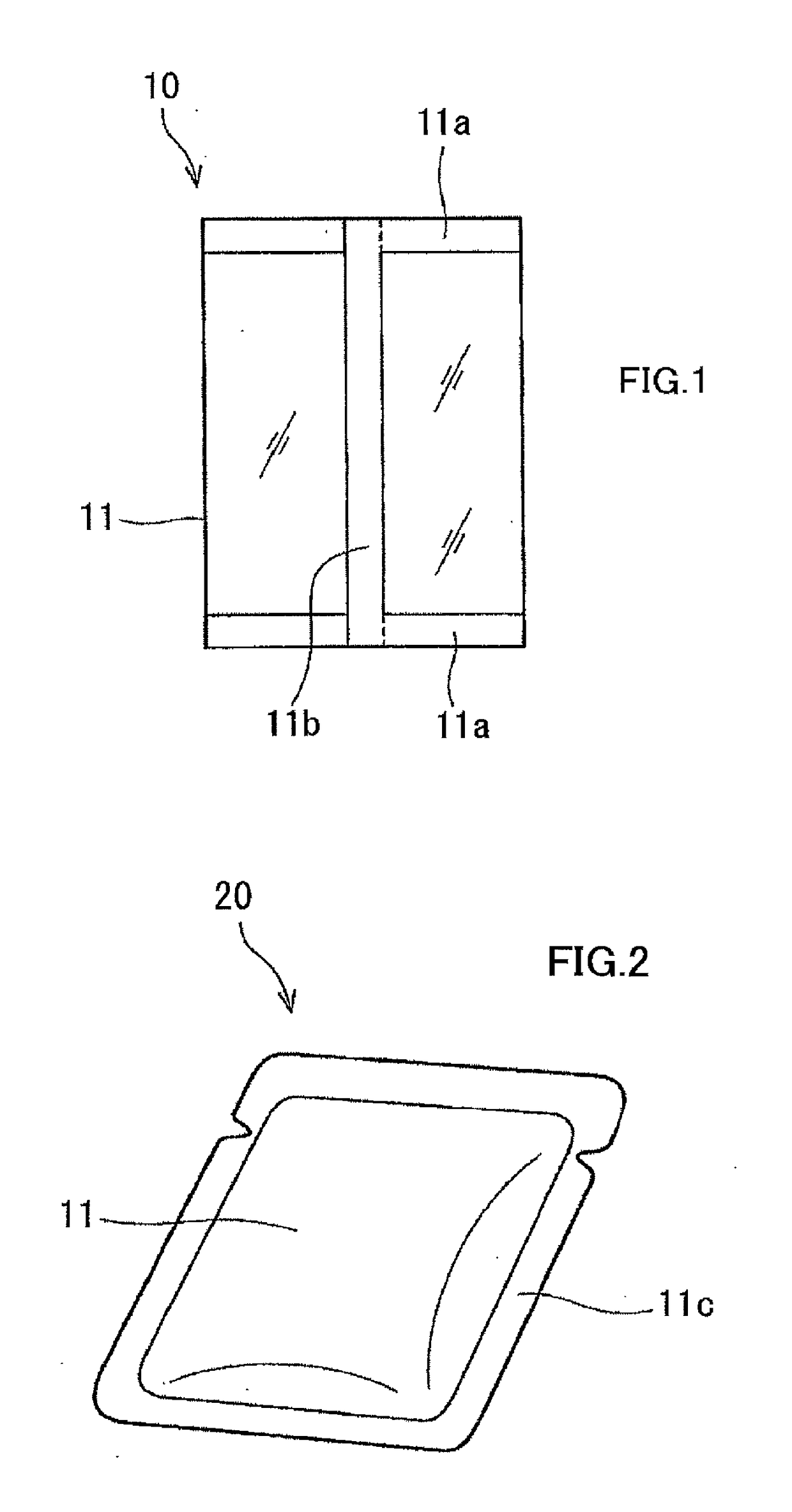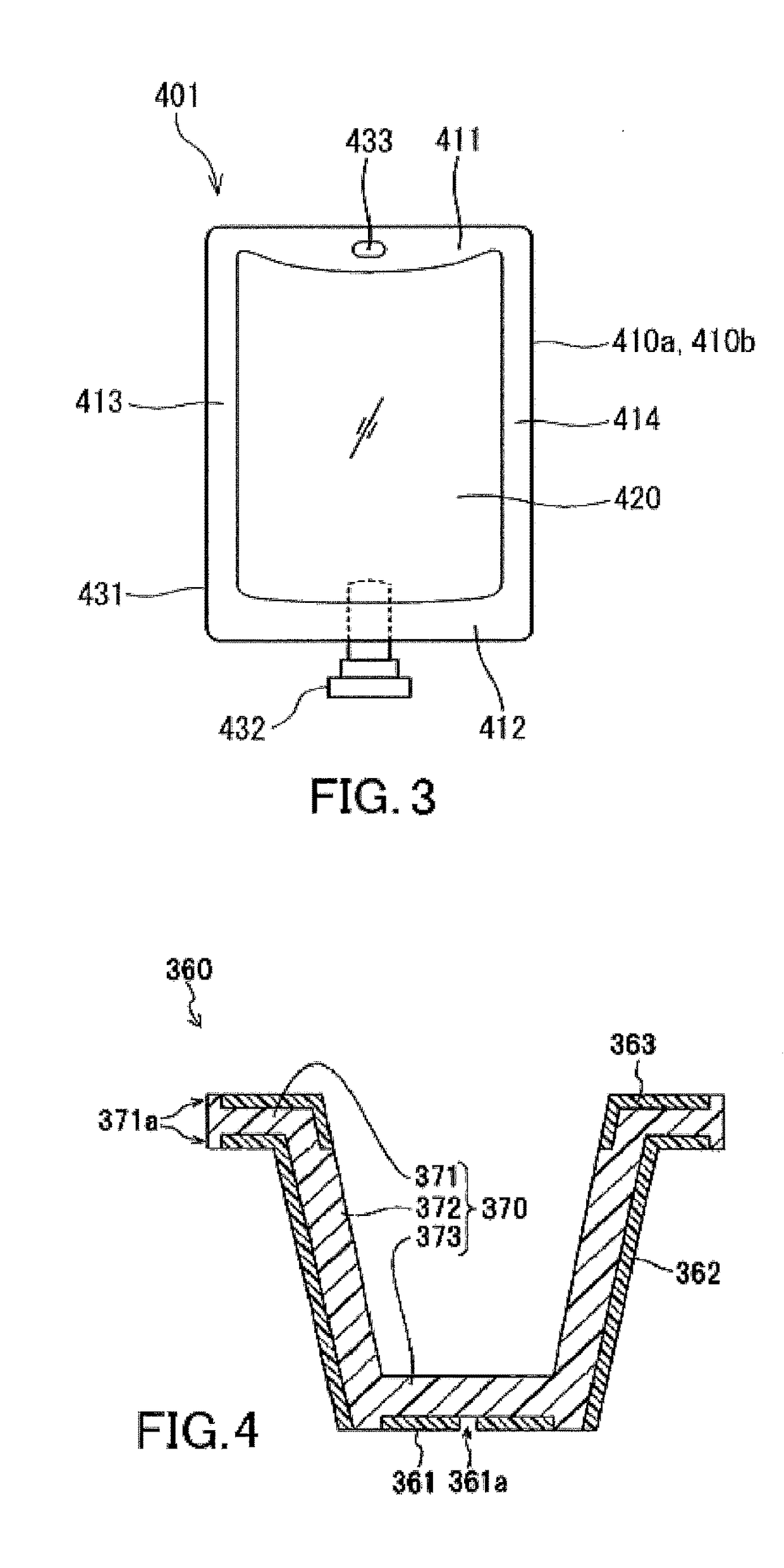Multilayer structure, method for producing same, packaging material and product including same, and protective sheet for electronic device
a multi-layer structure and packaging material technology, applied in the direction of pharmaceutical packaging, containers preventing decay, synthetic resin layered products, etc., can solve the problems of poor packaging appearance, low light transmittance, and poor barrier performance, and achieve good gas barrier properties, good water vapor barrier properties, and good retort resistance
- Summary
- Abstract
- Description
- Claims
- Application Information
AI Technical Summary
Benefits of technology
Problems solved by technology
Method used
Image
Examples
example 1
Example 1-1
[0333]First, a PET 12 (which may hereinafter be abbreviated as “X-1”) was prepared as the base (X). The coating liquid (S-1) was applied onto the base using a bar coater in such a manner that the dry thickness would be 0.3 μm. The film of the applied liquid was dried at 110° C. for 5 minutes to form a precursor of a layer (Y-1-1) on the base. In this way, a structure having a configuration of “base (X-1) / layer (Y-1-1) precursor” was obtained. Subsequently, the structure was heat-treated at 160° C. for 1 minute and then at 220° C. for 1 minute to form the layer (Y-1-1). In this way, a multilayer structure (1-1-1) having a configuration of “base (X-1) / layer (Y-1-1)” was obtained.
[0334]As a result of measurement of the infrared absorption spectrum of the multilayer structure (1-1-1), the maximum absorption wavenumber in the region from 800 to 1,400 cm−1 was determined to be 1,108 cm−1, and the width at half maximum of the maximum absorption band was determined to be 37 cm−1....
example 1-2
[0344]A vacuum insulator was fabricated using the multilayer structure (1-1-2) as obtained in Example 1-1. Specifically, the multilayer structure (1-1-2) was first cut into two pieces of a given shape. The two pieces of the multilayer structure (1-1-2) were then stacked together in such a manner that the CPP layers were located interiorly, and the resulting rectangular stack was heat-sealed at its three sides to form a bag. Next, a heat-insulating core material was put into the bag through the opening of the bag, and the bag was hermetically closed using a vacuum packaging machine (VAC-STAR 2500, manufactured by Frimark GmbH) so that the internal pressure was 10 Pa at a temperature of 20° C. In this way, a vacuum insulator was successfully fabricated without any problem. The heat-insulating core material used was a fine silica powder dried at 120° C. for 4 hours.
example 1-3
[0345]A solar cell module was fabricated using the multilayer structure (1-1-1) as obtained in Example 1-1. Specifically, first, an amorphous silicon solar cell placed on a 10-cm-square tempered glass plate was sandwiched between ethylene-vinyl acetate copolymer films with a thickness of 450 μm. The multilayer structure (1-1-1) was then bonded onto one of the films in such a manner that the PET layer of the multilayer structure (1-1-1) faced outwardly. In this way, a solar cell module was fabricated. The bonding was accomplished by vacuum drawing at 150° C. for 3 minutes, followed by compression bonding for 9 minutes. The solar cell module thus fabricated operated well and continued to show good electrical output characteristics over a long period of time.
PUM
| Property | Measurement | Unit |
|---|---|---|
| particle diameter | aaaaa | aaaaa |
| temperature | aaaaa | aaaaa |
| particle diameter | aaaaa | aaaaa |
Abstract
Description
Claims
Application Information
 Login to View More
Login to View More - R&D
- Intellectual Property
- Life Sciences
- Materials
- Tech Scout
- Unparalleled Data Quality
- Higher Quality Content
- 60% Fewer Hallucinations
Browse by: Latest US Patents, China's latest patents, Technical Efficacy Thesaurus, Application Domain, Technology Topic, Popular Technical Reports.
© 2025 PatSnap. All rights reserved.Legal|Privacy policy|Modern Slavery Act Transparency Statement|Sitemap|About US| Contact US: help@patsnap.com



